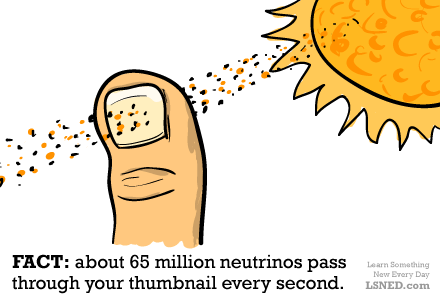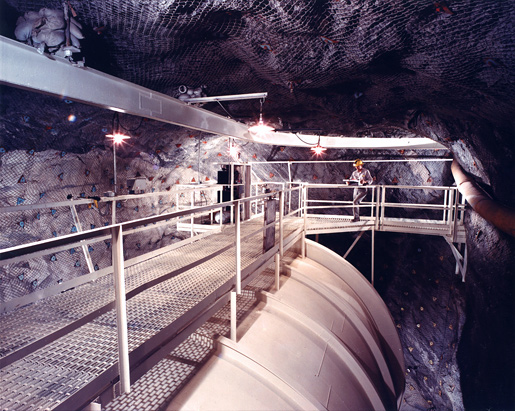
Ever heard of a neutrino?
Well, I guess now you have. But what exactly is a neutrino?
Don’t worry, they’re not harmful. They’re passing through you this very second and you’ll never notice them, not in your whole life. They’ll never hurt you because they just don’t interact with matter—including you—in the way you’d expect.
I’ll bet now you’re wondering where they even come from.
Well, as the diagram illustrates, they come from the sun. They’re kind of a side-effect of the nuclear reaction that powers the sun, and they radiate out from the sun in droves. But that’s not even the coolest bit.
We know how many neutrinos should come from the sun if our theories about its power generation are right. So if we can count them, we can prove those theories correct.
That’s when we encounter a bit of a problem. We can’t actually detect neutrinos.
So how the heck do we count them?
Neutrinos are strange things. But then, that’s not unusual for the tinier building blocks of matter, the particles smaller than even atoms. I mean, you can fit thousands of atoms across the head of a single pin. And neutrinos are a whole lot smaller.
When we want to study radiation, we construct telescopes.

We use optical telescopes to collect visible light, radio telescopes to collect radio waves, and a whole host of other types of instruments to study other bits of the electromagnetic spectrum. But all these devices use mirrors and lenses, and neutrinos just won’t cooperate.
They don’t behave for our detectors, either. You’d think we could use the same equipment we use to study other atomic particles, but neutrinos seem to like living in a land of mystery.
But we can detect them. See, neutrinos don’t always continue on their merry way unhindered. Pass them through chlorine atoms, and the chlorine atoms spontaneously turn into argon atoms.
Yeah, I know that sounds a bit weird. It’s something called radioactive decay, and I’ll save an explanation of that for another post.
The point, though, is that we can count neutrinos by counting every time a chlorine atom decays into argon.
There’s just one problem with this strategy. Neutrinos aren’t the only things that mess with chlorine.

There’s a type of radiation known as cosmic rays, and they’re just as mysterious as they sound. We’re not quite sure where they come from. We call them radiation, but they’re not part of the electromagnetic spectrum.
What we do know is that we have to get away from them to make sure our chlorine and neutrino experiment is completely accurate.
In the 1960s, a chemist named Raymond Davis Jr. figured out a way to get around the cosmic rays. He buried a 100,000 gallon tank of cleaning fluid in the bottom of a South Dakota gold mine. It contained chlorine, so he could count the neutrinos that passed through it.

Davis predicted, according to the theories of the time of how the sun worked, that he would detect a single neutrino every day. But that’s not what he observed at all. He only counted one neutrino every three days.
This, of course, stirred up a lot of questions. Up until then, scientists had been pretty confident that they understood the sun. But were their theories wrong? Or had the Davis experiment been faulty?
See, the scientific method is driven by evidence. If the evidence points to a theory, it’s probably true. Only one experiment to the contrary is enough to cast doubt on the theory—but it takes a lot more than that to convince scientists they’re wrong.
The Davis experiment counted only one third as many neutrinos as expected. Something was wrong somewhere. This bit of evidence couldn’t be dismissed. So physicists started looking for a way to figure out what was going on.
And eventually, they made the discovery that rocked their world.

At the quantum (sub-atomic) level, physics works in mysterious ways that are sometimes—in my opinion—a bit counterintuitive. And neutrinos are no different. Basically, they oscillate among three different types.
What does that even mean?
Truth be told, I don’t actually understand that bit myself. I do know that physicists call them flavors for some reason. I’m left to wonder if they taste good.
Anyway…the important question is, how do neutrino flavors have anything to do with the fault in Davis’s experiment?
Well…remember that Davis was trying to count neutrinos emitted by the sun. The sun only emits one of the flavors, and it just so happened that the Davis experiment was designed to detect that flavor. But there was one problem.
The flavor changed in the eight-minute journey from the sun to the Earth.
Yup, that’s right. What started out as the perfect flavor for Davis’s experiment became three different flavors by the time the neutrinos got to his chlorine tank. All three flavors passed through that tank—at a rate of one per day, just as expected.
But Davis’s experiment only detected the original flavor. So it only detected one out of every three neutrinos.
That’s the kind of weird thing that can go wrong with an experiment, especially at the quantum level.
When an experiment doesn’t yield the results you expected, it’s not necessarily because your theory was wrong. It could just be because you’re missing a crucial piece of information—information that would change how you did the experiment.
In the end, though, physicists were able to do the experiment right, and they were able to prove their theories about how the sun’s core behaves. So now we know…the sun is powered by nuclear fusion.
Would you allow me to use the image above (…. many neutrinos pass the thumbnail) for an online didactic publication (web page “Wissenschaft in die Schulen!”?
I would need therefore the author, the terms of use and the link to the original.
I would be very kind of you, if you could give me your consent.
With kind regards,
Olaf Fischer
LikeLiked by 1 person
Hi Olaf,
I apologize for failing to get back to you sooner. Unfortunately the photo doesn’t actually belong to me—I found it online. Do you have reason to believe I don’t have the right to use it myself? If so, my mistake—I’ll take it down.
Sorry I can’t be of more help!
LikeLike